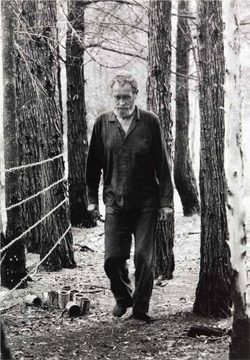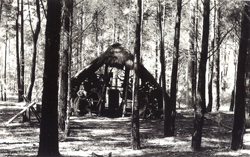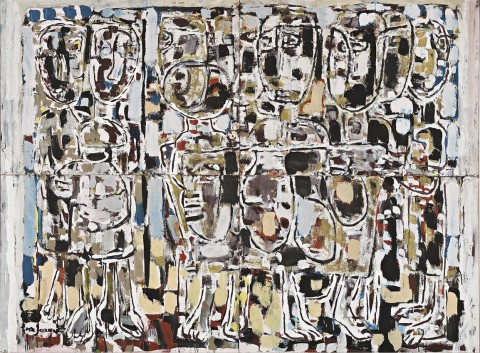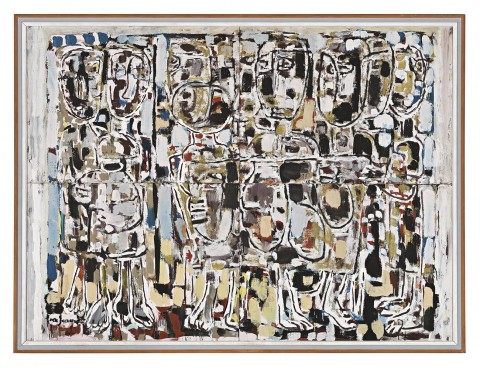BARBECUE, 1963
IAN FAIRWEATHER
synthetic polymer paint and gouache on cardboard on composition board (4 sheets)
134.0 x 181.5 cm
signed lower left: Ian Fairweather
bears inscription verso: BARBECUE
Macquarie Galleries, Sydney
Victor Macallister, Sydney
Thence by descent
Ellen Macallister, Sydney
Leonard French, Heathcote, Victoria, acquired from the above between 1966 and 1973
The Estate of Leonard French, Heathcote, Victoria
Ian Fairweather, Macquarie Galleries, Sydney, 31 July – 12 August 1963, cat. 7
Fairweather: a Retrospective Exhibition: Queensland Art Gallery, Brisbane, 3 June – 4 July 1965; Art Gallery of New South Wales, Sydney, 21 July – 22 August 1965; National Gallery of Victoria, Melbourne, 9 September – 10 October 1965; National Gallery of South Australia, Adelaide, 26 October – 21 November 1965; Western Australian Art Gallery, Perth, 9 December 1965 – 16 January 1966; Tasmanian Museum and Art Gallery, Hobart, 10 February – 13 March 1966, cat. 60 (lent by Victor Macallister) (label attached verso)
Fairweather, Queensland Art Gallery, Brisbane, 1 October – 27 November 1994; National Gallery of Victoria, Melbourne,17 December 1994 – 19 February 1995; Art Gallery of New South Wales, Sydney, 22 March – 7 May 1995, cat. 47 (lent by Leonard French) (label attached verso)
Bail, M., Ian Fairweather, Bay Books, Sydney and London, 1981, pl. 100, pp. 189, 191 (illus.)
Bail, M., Fairweather, Art and Australia Books in association with the Queensland Art Gallery, Brisbane, 1995, pl. 49, p. 121 (illus.)
Bail, M., Fairweather, Murdoch Books, Sydney, revised edition 2009, pp. 194,196
MacDonald, R., The Boy from Brunswick: Leonard French, a Biography, Australian Scholarly Press,Melbourne, 2018, p. 245
7.jpg

Ian Fairweather has been described as ‘the least parochial of Australian painters, an artist of exceptional force and originality’1 and he is undeniably one of the most singular artists to have worked in Australia during the twentieth century. Although he is claimed as an Australian and spent many years living here, he had a restless spirit and the story of his life reads like something borrowed from the pages of an adventure book. Born in Scotland, Fairweather undertook his formal art education at London’s Slade School of Fine Art, studying under the formidable Henry Tonks and in 1922, being awarded second prize for figure drawing. As a prisoner of war in Germany during the First World War he had access to books about Japanese and Chinese art, and later, studied these languages at night. In 1929 he sailed to Shanghai where he lived for several years, the country’s unique art, culture and philosophy having a lasting influence. Peripatetic by nature, or perhaps reluctant to establish roots and commit to ongoing relationships, Fairweather travelled extensively – from London, to Canada, China, Bali, Australia, the Philippines, India and beyond – ‘always the outsider, the nostalgic nomad with a dreamlike memory of distant places and experience’.2
The most dramatic chapter of Fairweather’s life was the extraordinary attempt he made in early 1952 to sail from Darwin to Timor on a raft which, according to the Times correspondent, ‘he built … with three old aircraft fuel tanks which he found in a dump, and the minute sail was fashioned from three panels of old parachute canopy. The raft was stocked with some tinned food, eight gallons of water, a blanket, and a change of clothing, and he set out on a trade wind’.3 Fairweather had researched the journey and studied the tides and, inspired in part by Thor Heyerdahl’s legendary Kon-Tiki expedition, calculated that he would reach his destination within ten days.4 Sixteen days later however, ‘after hallucinating, and being given up for dead, wearing only one shoe, he collapsed on the sand in the moonlight … at Roti, the last dot on the map west of Indonesian Timor’5 before the vast Indian Ocean and certain drowning. Interrogated in Indonesia, he made it to Timor briefly before being sent to Bali, deported to Singapore and then (as a British citizen) shipped back to London where his passport was confiscated until he repaid the cost of his fare. Fairweather said that Timor ‘(was) the next best thing to Bali where I had done the best painting of my life’6 but his motivation to leave Australia was also driven by a protracted period of unhappiness largely fuelled by his own anxiety and paranoia.
5. copy.jpg

In mid-1953 Fairweather returned to Australia and later that year settled on Bribie Island, off the coast of Queensland, where, for the rest of his life, he famously lived in a pair of huts built with materials salvaged from the surrounding bush. The conditions were primitive – no running water, sewerage or electricity – and Fairweather’s handmade bed and chairs were reportedly upholstered with fern fronds.7 Despite the rudimentary nature of his surrounds however – or perhaps because of it – the next two decades witnessed the production of many of Fairweather’s finest paintings and the 1960s saw his art acknowledged in significant ways, with works being included in the landmark exhibition Recent Australian Painting at the Whitechapel Gallery, London (1961), the European tour of Australian Painting Today (1964 – 65) and in 1965, a major travelling retrospective of his work – which included the painting on offer here – was mounted by the Queensland Art Gallery.
Pierre Ryckmans has explained Fairweather’s apparent disdain for material comforts and regular human interaction as the consequence of a need that was both innate and profound: ‘he needed to paint like one needs to breathe; had he dropped his brush, he would have suffocated’.8 Arguing that his passion was based in the activity of painting rather than in the finished works themselves, he also provides a compelling explanation for why Fairweather was so notoriously haphazard about the materials and techniques he used, and the careless indifference with which he stored and transported them – put simply, the process was more important than the result. Black and white photographs of the studio hut show tables covered cheek by jowl with tins of paint, many open with brushes in them, ready and waiting to be used. Surfaces are covered with random spatters and dribbles of paint, colours layered one on top of the other creating a visual trace of the pictures produced there. Beyond his basic requirements Fairweather was also largely disinterested in the commercial rewards of making art and when, in the late 1950s, Macquarie Galleries suggested an increase to the cheques they regularly sent, he replied, ‘No I am not anxious to draw money in larger amounts – paintings materialise so uncertainly and slowly that the chief consideration is to endure – long enough to finish something’.9
The end of 1956 saw the construction of a second, larger hut which heralded the production of paintings on a bigger scale such as Roi Soleil, 1956 – 57, and its purchase by the Art Gallery of New South Wales the following year was encouraging. Soon after, Fairweather began to use the new synthetic polymer paint (often in combination with gouache) which dried quickly and, unlike oil paint and other less stable media, suited his way of working. Returning to pictures again and again over an extended period of time, he developed complex, layered images which vibrate and shimmer with movement.10 Fairweather himself recognised a distinctive shift in the work produced following the move to Bribie, dismissing what had come earlier as ‘nothing new’ and, although his self-assessment was unduly harsh, the major works of the late 1950s and 60s are powerful expressions of an artist in full flight.
This group includes Hallelujah, 1958, Monastery, 1961, Monsoon, 1961 – 62 and Shalimar, c.1962, all of which hang on the walls of Australia’s state and national galleries,11 and, in Murray Bail’s words ‘stand apart in a solitary sort of grandeur from other modern Australian paintings … there is nothing quite like them anywhere. They are so distinctive, of such depth, they don’t fit national boundaries or ‘schools’’.12 Despite Fairweather’s isolation from the art world, he often sent work to Sydney where it was shown at Macquarie Galleries. In 1963, the year he represented Australia in the São Paulo Biennial, his solo exhibition included fifteen paintings, the two major statements – each priced at 750 guineas – being Marriage at Cana, now in the collection of the National Gallery of Australia, and Barbecue. Writing in The Bulletin, art critic John Henshaw described the exhibition as ‘capable of quickening the pulse’ and noted that ‘the bigger (paintings have) … greater mastery, as if the wider challenge elicited the deepest response. The mystique here is committed to basic humanism, the technique to an involved fusion of Eastern and Western attitude’.13
resize.jpg

Ian Fairweather
Marriage at Cana, 1963
synthetic polymer paint and tempera
on cardboard mounted on
composition board
137.7 x 195.5 cm
courtesy of National Gallery
of Australia, Canberra
Both works are painted on four sheets of cardboard laid down onto a hardboard support just under two metres wide – they are grand in scale and monumental in vision. Where Marriage at Cana uses a refined series of abstract lines against a clean background to symbolise its miraculous biblical theme, the very secular, everyday subject of Barbecue is depicted with a more figurative approach. In its bold outlining of forms – heads, torsos and legs lined up across the surface – and free application of paint, Barbecue recalls the French artist Jean Dubuffet, whose work was known and admired by Fairweather. The overall tonal brilliance of the picture conjures up the light that is so distinctive and characteristic of an Australian summer and Fairweather’s palette reflects the environment he knew so well, from the sun-drenched yellow of the sand, glimpses of the ocean’s various shades of blue and pale skin becoming tanned. Colour, line and form reverberate against each other in this image, pulsating with a palpable energy that speaks directly and yet eloquently of Fairweather’s process and his creative passion. It should come as no surprise that this work was owned for many years by Leonard French, a significant Australian artist whose individuality and commitment to his art mirrored that of Fairweather. In the decade since he had settled on Bribie Island, its pristine beaches and untouched landscape had become increasingly popular as a destination for holiday-makers and their presence continued to encroach on Fairweather’s solitude. They also provided him with unexpected inspiration and this scene was probably witnessed at a public barbecue on a beach looking out across the ocean, or Pumicestone Passage on the mainland side, an often-frequented picnic area not far from his hut.
3..jpg

1. Bail, M., Ian Fairweather, Bay Books, Sydney, 1981, p. 220
2. Bail, M., ‘The Nostalgic Nomad’, Hemisphere, Canberra, vol. 27, no. 1, 1982, p. 54
3. ‘Timor Sea Crossed on Raft – Scottish Artist’s Feat’, The Times, 9 August 1952, reproduced in Bail, M., Fairweather, Murdoch Books, Millers Point, 2000
4. Abbott-Smith, N., Ian Fairweather: Profile of an Artist, University of Queensland Press, Brisbane, 1978p. 104
5. Bail, M., 2000, op. cit., p. 103
6. Bail, M., 1981, op. cit., p. 115
7. Bail, M., 2000, op. cit., p. 103
8. Ryckmans, P., ‘An Amateur Artist’ in Bail, M., Fairweather, Art and Australia Books in association with the Queensland Art Gallery, Brisbane, 1995, p. 18
9. The artist to Terry Smith, around April 1957, quoted in Bail, 1981, p. 128
10. Eagle, M., ‘The Painter and the Raft’ in Bail, M., 1995, op. cit., p. 22
11. These paintings are in the collections of the National Gallery of Victoria, National Gallery of Australia, Art Gallery of Western Australia and Queensland Art Gallery respectively.
12. Bail, M., 1995, op. cit., p. 11
13. Henshaw, J., ‘Fairweather’, The Bulletin, vol. 85, no. 4358, 31 August 1963, p. 38
KIRSTY GRANT

